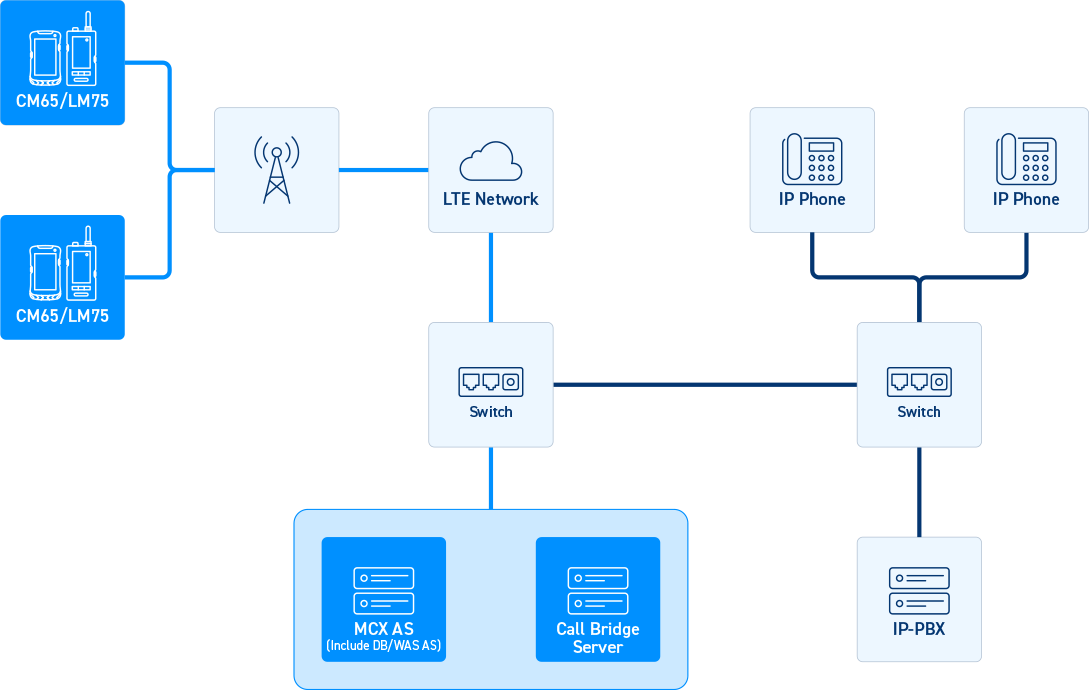PaBX
PaBX integration refers to connecting Mission Critical Push-To-Talk (MCPTT) services with legacy enterprise voice systems, such as IP-PBX, through Cybertel Call Bridge Server.
This enables seamless voice communication between MCX users and office phone users, enabling 1:1 voice/video calls, SIP trunk-based routing and full duplex calling beyond LTE boundaries.
Key Benefits
-
Interoperability with Existing Telephony
Bridges PTT systems with PaBX environments.
-
Full Duplex Communication
Supports 1:1 voice and video calling between MCX and IP phone users.
-
Flexible Routing and Control
Prefix-based routing, class control and number translation supported.
-
Detailed Call Records
Call Detail Records (CDR) available via 3rd-party SMDR interfaces.
Use Cases
- Emergency dispatcher communicating directly with office desk phones
- Connecting field responders to headquarters via enterprise PaBX
- Voice interconnection between MCX clients and landline or SIP phones
Integration Reference Point
System Architecture: MCX + Call Bridge + PaBX
Cybertel Call Bridge Server acts as a SIP trunking gateway between Call Bridge Application Server and 3rd-party IP-PBX systems.
| Component | Role |
|---|---|
| Call Bridge Server | SIP gateway and routing engine |
| MCX WAS | Manages provisioning and routing policies |
| PaBX | External voice system (office phone network) |
Integration Reference Point
The integration reference is between:
Call Bridge Server ↔ External PaBX (via SIP trunk)
-
Technical Highlights:
- SIP/SDP protocol (RFC 3261, 2327)
- Codec support: G.711, G.729AB, H.264, H.263
- SIP Port: 5076 (default)
- Media Ports: Audio 45000–45999, Video 55000–55999
-
Call Flow Example
- 1. MCX user dials a prefix number (e.g., "6~")
- 2. Call Bridge routes call via SIP trunk to the mapped PaBX
- 3. Media session is established (voice/video)
- 4. Full duplex call continues until terminated by either side
Both TCP and UDP transport supported
Automatic prefix routing and digit conversion supported
Cybertel PaBX Solution
Key Capabilities
-
VoIP Security
Authentication, registration control and real-time session monitoring
-
Call Features
- Call Monitoring, Hold, Hunting, Forwarding
- CID (Caller ID), DND (Do Not Disturb), Duration Control
- Class-based Routing (Domestic, Mobile, ISD)
-
Web-based Admin Console
- User/device management
- Routing rule configuration (Prefix, IP, Group)
- Real-time session status view
-
MBMS Restoration Handling
Auto-recovery when BMSC fails (based on restart counters and TCP link health checks).
Flexible Deployment Options
-
Tenant-Level Configuration
Support for multiple PaBX systems in multi-tenant environments
-
Scalable Architecture
Supports from 100 to 2,000 concurrent users
-
CDR Export & B/OSS Integration
Available through syslog, JSON, or custom APIs for usage tracking
-
MBMS Restoration Handling
Auto-recovery when BMSC fails (based on restart counters and TCP link health checks).

Why Choose Cybertel?
- Proven interworking with national-level infrastructure
- SIP-compliant and enterprise-ready
- Integrated with MCX, WAS and BSS/OSS
- Customizable for enterprise PBX environments


